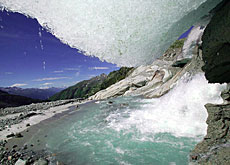Glaciers disappearing faster than expected

A new study has shown that Swiss glaciers shrunk by about one-fifth between 1985 and 2000 – a much higher rate than expected.
Satellite data analysed by Zurich University found that, overall, the melting of glaciers in Switzerland had accelerated over the past thirty years.
These latest results surpass previous estimations of a loss of less than 30 per cent by the year 2025.
The Zurich study shows that between 1985 and 2000, Swiss glaciers lost 18 per cent of their surface, while 22 per cent disappeared across the whole of the Alpine region.
And this is not all. From 1973 to 2000, the shrinkage accelerated by a factor of three, while from 1985 to 2000 it had risen to a factor of seven.
Rather intense
Frank Paul, who carried out the research at Zurich University’s Department of Geography, said the decline was “rather intense”.
He explained that the glaciers’ retreat was mainly due to higher temperatures in the 1990s, especially in the Alps.
Over the past 150 years, an increase of 0.6 of a degree in temperature has been registered in Switzerland, compared with a rise of between one and 1.5 degrees in the Swiss mountains.
The study found that it was mainly the small glaciers that suffered from the higher temperatures. Small glaciers make up only 18 per cent of all glaciers in Switzerland, but they account for 44 per cent of all losses.
Kiss of death
Although it is not yet clear what impact the very hot summer of last year will have on the glaciers, Paul is warning that it could have been the “kiss of death” for many of them. On average, the ice thickness was reduced by three metres in 2003 alone.
Paul added that it would be too risky to give a forecast for the future. But Zurich University has said that it believes the ice will continue to melt.
The university’s research was – for the first time – automatically evaluated using data from the Landsat satellite.
Landsat has been flying over the same region every 16 days for the last 20 years and covers a sector 185 kilometres wide.
Until now, most glacier studies relied on pictures taken from the air that were evaluated by hand, a process that took several years.
The new method used can make an analysis of the data in a matter of months.
The research work, part of a study by the Swiss National Science Foundation, is a pilot study for an international project to make an inventory of the world’s glaciers using satellite data.
swissinfo with agencies
Swiss glaciers lost 18 per cent of their surface area between 1985 and 2000, while the entire Alpine region lost 22 per cent.
From 1973 to 1985, the loss was only one per cent.
From 1973 to 2000, the loss accelerated by a factor of three.
From 1985 to 2000, the loss accelerated by a factor of seven.
Warmer temperatures have affected small glaciers in particular.
Small glaciers account for 18 per cent of the total surface area of glaciers in Switzerland.
But they account for 44 per cent of the total disappearance of glaciers.
Swiss glaciers are melting at a somewhat lower rate than in the whole Alpine region because they are generally at a higher altitude.

In compliance with the JTI standards
More: SWI swissinfo.ch certified by the Journalism Trust Initiative










You can find an overview of ongoing debates with our journalists here . Please join us!
If you want to start a conversation about a topic raised in this article or want to report factual errors, email us at english@swissinfo.ch.